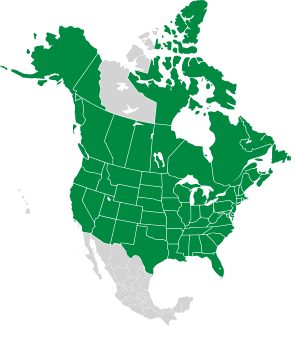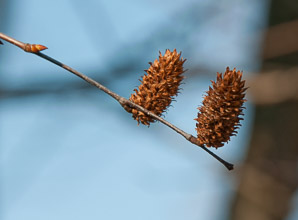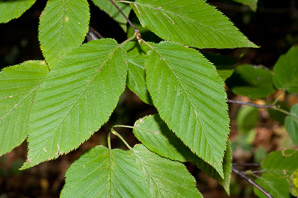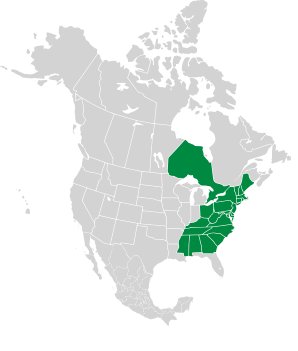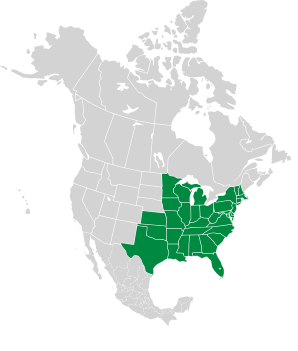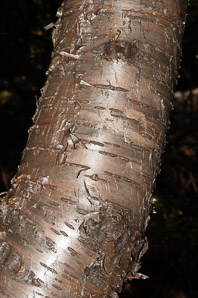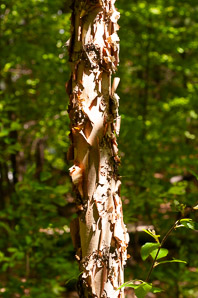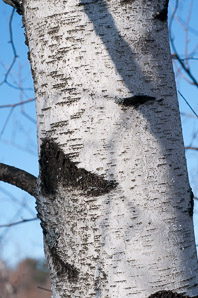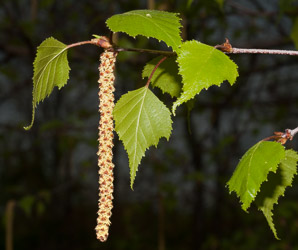
|
Betula L.
The Betula genus—birch trees—consists of about 30 species of mid-sized trees. (That's BET-u-la.) They are widespread throughout the northern hemisphere. Among the most common are several with unmistakable white, papery bark—"birch" means "white, bright; to shine." Birch bark has several other unusual properties. It has long, horizontal lenticels (essentially air vents). It is remarkably waterproof, persisting for long periods after the death of the tree, and favored for this reason (and for lightness) in the construction of canoes. This same waterproof property makes birch bark excellent kindling for a fire. Identification: White birch and gray birch both share bright white bark, an unmistakable indicator. Several other birch trees have bark that tends to be shaggy, peeling easily. The table below compares some common species: |
Birch (Betula) · 11/26/2011 · Nashua River Rail Trail, East Pepperell, Massachusetts · ≈ 3 × 2″ (8.4 × 5.6 cm) Yellow birch (Betula alleghaniensis) · 10/2/2010 · Hackers Trail, Cliff Park, Delaware Water Gap National Recr, Pennsylvania · ≈ 8 × 5″ (19 × 13 cm) |
|||||||||||||||||||||||||
|
| ||||||||||||||||||||||||||
Betula alleghaniensis |
Betula lenta |
Betula nigra |
||||||||||||||||||||||||
|---|---|---|---|---|---|---|---|---|---|---|---|---|---|---|---|---|---|---|---|---|---|---|---|---|---|---|
| Common Name |  |
 |
 |
|||||||||||||||||||||||
| Plant | Trees are 60-70′ (18-21 m) tall, rarely reaching 100′ (30 m). Tree shape is pyramidal in young trees, and usually uneven in mature trees. | Trees are up to 82′ (25 m), rarely reaching 98′ (30 m). They often have multiple trunks. Trees tend to be pyramid-shaped when they are young, becoming more irregular as they age. | ||||||||||||||||||||||||
| Flowers | Yellow birches have both male and female flowers on the same tree. Male flowers are catkins near twig ends, 1″ (2.5 cm) long and reddish green. Female flowers point upright. They are ⅝″ (1.7 cm) long and reddish-green. | Male and female flowers appear on the same tree. Male catkins are up to 3″ (7.6 cm) long in April; female flowers are inconspicuous. | ||||||||||||||||||||||||
| Leaves | Leaves are alternate and unlobed, 2-4½″ (6-12 cm) long and half as wide. | Leaves are dark green, alternate, unlobed. They are roughly diamond-shaped, with the top half of the diamond more pointed and with doubly serrated edges, while the bottom half is flatter and with smooth edges. Leaves turn yellow in the fall. | ||||||||||||||||||||||||
| Stem | The yellowish-bronze bark, easily peeled as with other birches, is unique in appearence; the inner bark has a slight odor or wintergreen. | Bark is highly variable. As with other birches, it peels away spontaneously ("exfoliates"), making the trunk look ragged. It may be dark gray-brown and scaly, pinkish-brown, or white and papery. | ||||||||||||||||||||||||
| Fruit | Fruits resemble small cones, ¾-1¼″ (1.9-3.2 cm) × ¼-⅜″ (6.3-9.5 mm). | |||||||||||||||||||||||||
| Range/ Zones |
|
|
|
|||||||||||||||||||||||
| Habitats | Floodplains, swamp or river boundaries. | |||||||||||||||||||||||||
| Type | Wild | Wild | Wild | |||||||||||||||||||||||
Betula papyrifera
Betula papyrifera cv. ‘Renaissance Reflection’
Betula populifolia


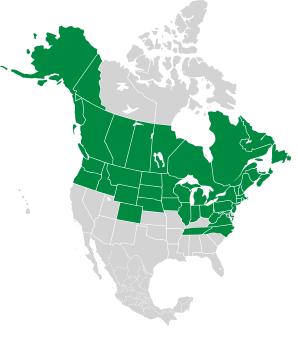
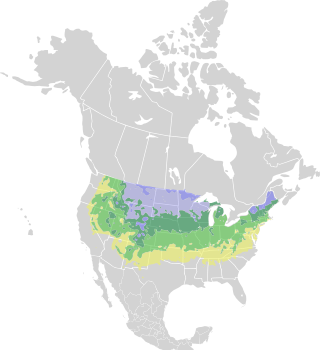
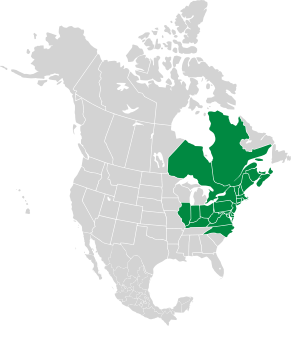
Online References:
References:
Sibley, David Allen, The Sibley Guide to Trees, Alfred A. Knopf, 2009
Petrides, George A., Peterson Field Guides: Trees and Shrubs, Houghton Mifflin Co., 1972
Dirr, Michael A., Dirr’s Hardy Trees and Shrubs, Timber Press, 1997
Symonds, George W. D.; photos by Chelminski, Stephen V., The Tree Identification Book, Harper, 2003
Yellow birch (Betula alleghaniensis) · 10/6/2011 · Pack Monadnock, 2200', Peterborough, New Hampshire · ≈ 8 × 12″ (20 × 31 cm) 
River birch (Betula nigra) · 5/15/2010 · Garden in the Woods, Framingham, Massachusetts · ≈ 1 × 1½′ (34 × 52 cm) 
Betula description by Thomas H. Kent, last updated 16 Sep 2020.
© FloraFinder.org. All rights reserved.
Gray birch (Betula populifolia) · 3/10/2010 · Nashua River Rail Trail, Groton Center, Groton, Massachusetts · ≈ 9 × 14″ (23 × 35 cm) ![]() ID is uncertain
ID is uncertain 
Gray birch (Betula populifolia) · 5/2/2010 · Nashua River Rail Trail, Groton Center, Groton, Massachusetts · ≈ 7 × 4½″ (17 × 11 cm) 
Range:
